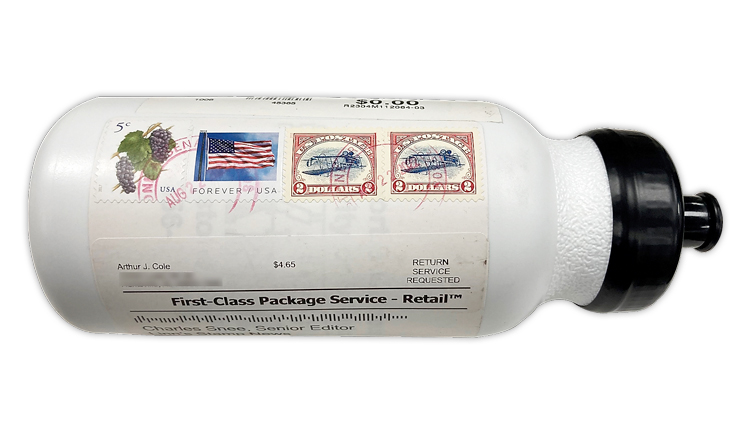US Stamps
Inside Linn’s: 2013 Jenny Invert stamps send a message in a bottle

By Charles Snee
The May 1 digital-only issue of Linn’s Stamp News will be available to subscribers Saturday, April 15. While you wait for your issue to arrive, enjoy these three quick glimpses of exclusive content available only to subscribers.
2013 Jenny Invert stamps send a message in a bottle
The $4.65 franking on the plastic water bottle pictured above includes two United States 2013 $2 Jenny Invert stamps. In Dollar-Sign Stamps, Charles Snee takes a closer look at this rather unusual piece of postal history. Among other things, Snee notes that the franking exactly satisfied the rate for a first-class package mailed to a zone 4 address. A Linn’s reader in Alabama mailed the bottle to Snee from Redstone Arsenal, a U.S. Army post next to Huntsville, Ala. In addition to a message, the bottle also contained three other items. Snee has the details in his column.
Tip of the Week: a popular constant plate variety
In this week’s tip, Stamp Market Tips columnists Henry Gitner and Rick Miller recommend looking for a popular constant plate variety: the “prairie dog,” which is found on the United States 5¢ Globe and Airplane stamp (Scott 650) of the 1928 Aeronautics Conference issue. “This plate variety is from position 50 in the plate of 200 from plate number 19658,” Gitner and Miller explain. “All examples have a natural straight edge at the right side.” The flaw resembles a prairie dog perched atop the airplane’s wing. A close-up of the flaw is pictured with Gitner and Miller’s tip.
Kitchen Table Philately: worldwide stamps from a 4-ounce packet
In each weekly issue of Linn’s, either E. Rawolik VI or E. Rawolik VII dissects the contents of a stamp mixture offered to collectors. E. Rawolik is a pseudonym that is also the word “kiloware” (a stamp mixture) spelled backward. This week, E. Rawolik VI reviews a sample of 236 stamps selected for their interest and/or value from a $20 4-ounce packet of worldwide stamps. This is a departure from a typical KTP review, in which stamps are selected at random. Rawolik was most pleased with the results. Almost half of the stamps had a Scott catalog value of $1 or more. Rawolik found “a heavy concentration of stamps from Canada, Great Britain and Germany, with many more countries thrown in for good measure.” The stamp with the highest catalog value, $22.50, came from one of those three countries. Enjoy the full review in this issue.
Connect with Linn’s Stamp News:
Sign up for our newsletter
Like us on Facebook
Follow us on Twitter
MORE RELATED ARTICLES
Headlines
-
US Stamps
Oct 7, 2024, 12 PMVasiliauskas named president of Mystic Stamp Co.
-
US Stamps
Oct 6, 2024, 5 PMApgar souvenir card available
-
US Stamps
Oct 6, 2024, 4 PMFirst Continental Congress and U.N. stamps receive Scott catalog numbers
-
World Stamps
Oct 5, 2024, 1 PMCanada Post continues Truth and Reconciliation series








